Never A Bad Day At Logan Pass
PURSUING PHOTOS AND PROSE
With Kayaks, Mountain bikes, Backpacks, Daypacks, Walking Sticks, Fishing Poles—and an Airstream Travel Trailer
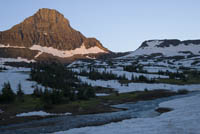 ©Bert Gildart: Logan Pass in Glacier National Park is a photographer’s delight, even when a few stacked clouds interpose themselves between my camera and the sun that in June rises over the Garden Wall about 5:30 a.m. On days when the sun is unfiltered, it can illuminate Mount Reynolds, Mount Clements, Bear Hat, Heavy Runner, Bishop’s Cap—and a host of other grand mountains in ways that can create some of the most stunning and compelling compositions in the country. Point your camera in almost any direction, and daybreak at Logan Pass on a sunny day can not be beat.
©Bert Gildart: Logan Pass in Glacier National Park is a photographer’s delight, even when a few stacked clouds interpose themselves between my camera and the sun that in June rises over the Garden Wall about 5:30 a.m. On days when the sun is unfiltered, it can illuminate Mount Reynolds, Mount Clements, Bear Hat, Heavy Runner, Bishop’s Cap—and a host of other grand mountains in ways that can create some of the most stunning and compelling compositions in the country. Point your camera in almost any direction, and daybreak at Logan Pass on a sunny day can not be beat.
Yesterday morning, however, conditions were not ideal, but that doesn’t mean we had a bad day.
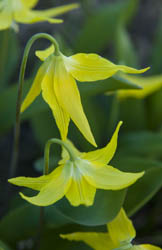 Expecting a repeat of the faultlessly blue skies we’d been enjoying all week long in Montana’s Flathead Valley, I rendezvoused at 4:30 a.m. with photographer friend Tom Ulrich and the two of us made the 40-minute drive from West Glacier to Logan Pass along the famed Going-to-the-Sun Road. Because torrential rains had produced mud slides that covered the road, the road opened later this year then it had in decades, frustrating us photographers, desirous of making our annual pilgrimage to this mountainous shrine. But our early morning jaunt was worth the effort despite the muted sun.
Expecting a repeat of the faultlessly blue skies we’d been enjoying all week long in Montana’s Flathead Valley, I rendezvoused at 4:30 a.m. with photographer friend Tom Ulrich and the two of us made the 40-minute drive from West Glacier to Logan Pass along the famed Going-to-the-Sun Road. Because torrential rains had produced mud slides that covered the road, the road opened later this year then it had in decades, frustrating us photographers, desirous of making our annual pilgrimage to this mountainous shrine. But our early morning jaunt was worth the effort despite the muted sun.
Practiced photographers learn to work under a variety of conditions, and after over 30 years of making images, I place my self in that category, and when the light was not perfect for landscapes we turned to flowers now emerging.
Up here at 6,000 feet, spring arrives late, and flowers that we’d seen in the valley were only now appearing at Logan Pass.Brilliant yellow glacier lilies carpeted areas that were covered with snow just days before, and they interspersed themselves between the vast banks of snow that still covered the ground.
These lilies derive their energy from tubers that are edible.
In the spring, they are a favorite food of grizzly bears and so we maintained a wary eye. Other plants emerging include the anemones and the tiny spring beauty, and we focused on them, too.
And then, we found a white-tailed ptarmigan, now in summer plumage, and for awhile we photographed this exceedingly tolerant species, wondering at times how it had escaped its many predators.
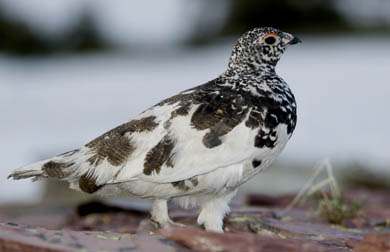
Because the sun was still muted, we used flashes, creating the type of light that makes for better photographs.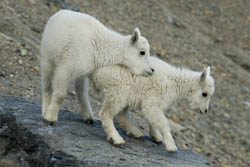
But our greatest find of the morning were several families of goats, which we stumbled across as we left Logan Pass and began our return home.
For both Tom and me, the chance encounter provided wonderful opportunities. The goats were all poised on rocks and two kids (the goat kind) seemed to be playing a game that we might call “King of the Mountain.”
First, one of the two young would leap on the rock, followed close behind by the other, who would try and shove off the first. From such play, young kids develop strength and coordination. The pair looked as though they had been born only weeks earlier and how they contrasted with the adult billies and ewes.
Both of the kids were fully furred, unlike the adults that were now shedding in great swaths. Because so much bare skin showed on the adults, they appeared to be suffering from the mange, but it’s all a normal response to summer heat.
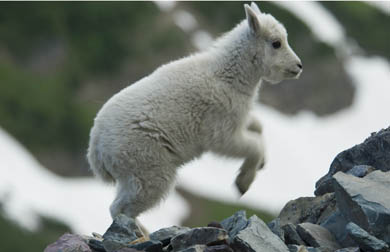
Newborns, however, need the extra warmth.
Despite the washed out sun, we both considered the trip worth the effort. We had arrived at 5 a.m. and were now departing at 9 a.m., and as we did, we turned for one last photograph of a big billy that suddenly emerged from a rocky crevasse.
Looking at the image on the screen of my Nikon D-200, I realized that it is almost impossible to ever have a bad day at Logan Pass.

